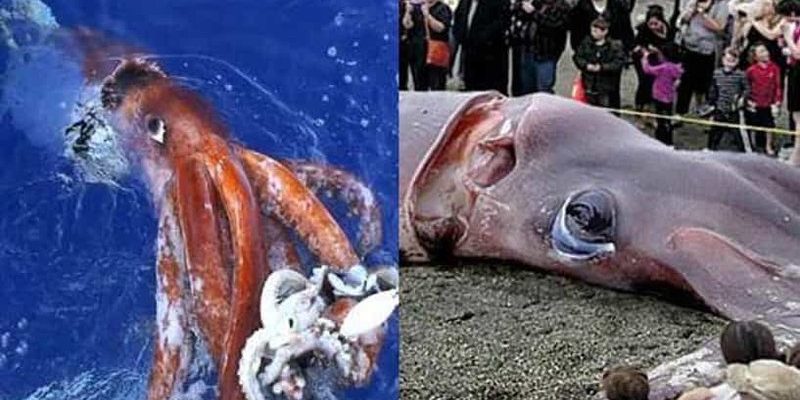
These elusive giants inhabit the depths of the ocean, making them incredibly mysterious and not easy to study. Some might think of them as the sea’s equivalent of the Loch Ness Monster. Stories of giant squids have fueled our imaginations, but science has begun to unveil some truths about these fascinating creatures. So, grab your favorite coffee, and let’s dive into some amazing facts about the giant squid that may surprise you!
1. Size Matters: The Truly Giant Scale
When we talk about the giant squid, we aren’t just referring to a slightly larger version of your average squid. These creatures can grow to amazing lengths, often reaching up to 43 feet (13 meters) or more. That’s longer than a school bus! Their bodies can weigh up to 600 pounds (272 kg), making them one of the largest invertebrates on Earth.
To put it into perspective, think about how big that is. If you’ve ever seen a large whale, the giant squid is nearly as long as some of the smaller species. Their size is a key aspect of their survival, allowing them to navigate and hunt in the dark depths of the ocean, where they reside.
2. Anatomy of a Giant: Unique Features
The giant squid has some striking physical features that set it apart from other marine creatures. They possess large eyes, which can measure up to 10 inches (25 cm) in diameter—one of the biggest eyes in the animal kingdom. These massive eyes help them see in the dim light of the deep ocean, where sunlight barely penetrates.
Another unique aspect is their tentacles. Unlike their smaller cousins, giant squids have eight arms and two longer tentacles used for capturing prey. These tentacles are equipped with numerous suckers that can grip tightly, making it easier for them to snag fish and even other squids. Isn’t that fascinating?
3. Masters of Camouflage
Have you ever noticed how some animals can blend into their surroundings? The giant squid is a master of camouflage. Thanks to specialized cells in their skin called chromatophores, they can change color and patterns. This ability allows them to hide from predators or surprise prey.
Imagine a giant squid silently drifting through its habitat, shifting from deep reds to muted browns, seamlessly blending with the ocean’s floor. This makes them incredibly difficult to spot, even for the most seasoned divers. It’s like a game of hide and seek in the depths!
4. Habitat: The Depths of Mystery
Giant squids are often found at depths ranging from 1,000 to 3,000 feet (300 to 1,000 meters) beneath the ocean’s surface. This is where the water is dark and cold, and sunlight doesn’t reach. Living in such extreme conditions means they have adapted to a unique lifestyle that many marine creatures can’t handle.
You might be wondering, how do they even find each other out there in the dark? They’re not the most social creatures, so most of their interactions are when they come together to mate or when they encounter prey. This isolation adds to their mysterious reputation!
5. Feeding Habits: What’s on the Menu?
Now, let’s talk about what the giant squid eats. These creatures are opportunistic hunters and primarily feast on fish, crustaceans, and even other squids. They use their tentacles to grab their prey and then bring it to their beak-like mouth.
Interestingly, they are known to be prey for some larger species, like sperm whales. These whales have been known to dive deep into the abyss to hunt giant squids. It’s a predator-prey relationship that showcases the harsh realities of ocean life.
6. Reproduction: A Mysterious Process
Giant squids have a rather intriguing and somewhat mysterious reproductive process. Little is known about how they mate, as they live in such deep waters that scientists have struggled to observe this behavior. However, what we do know is that females can lay thousands of eggs at once.
After laying eggs, the female squid usually dies shortly afterward, which is not uncommon in the squid family. The eggs then hatch, and the young squids must fend for themselves right from the start. Talk about diving into life!
7. Cultural Impact: Legends and Lore
The giant squid has a prominent place in various cultures throughout history. From ancient sailors’ tales of sea monsters to modern films like “20,000 Leagues Under the Sea,” these creatures have often been depicted as fearsome beasts.
These stories have contributed to the giant squid’s mythos and have kept the public intrigued. Could they really be the stuff of legends? While they may not be as fearsome as depicted, they’re definitely impressive and deserving of attention.
8. Scientific Study: A Challenge
Studying giant squids is no easy feat. Since they live in such deep, dark waters, it’s challenging for scientists to observe them in their natural habitat. Much of what we know has come from examining dead specimens that wash ashore or are caught in fishing nets.
Technological advancements, like deep-sea submersibles and underwater cameras, are finally beginning to give us more insight into their lives. Each discovery adds a piece to the puzzle of understanding this enigmatic creature.
9. Giant Squid and Human Interaction
While we may not encounter giant squids regularly, they’ve still made their mark on human history. There have been reports of giant squids attacking fishing boats and even a few documented encounters with divers, though these interactions are rare.
The fascination with giant squids continues to inspire films, books, and documentaries. They capture the imagination and push us to explore the ocean’s depths more thoroughly, prompting the question: what other secrets are waiting to be discovered?
10. Conservation Status: Protecting the Giants
As ocean environments change due to overfishing, pollution, and climate change, the conservation status of giant squids is something to consider. While they are not currently listed as endangered, their habitats face significant threats. The health of the oceans is crucial for the survival of all marine life.
Protecting the ocean involves a collective effort to minimize pollution and ensure sustainable fishing practices. By taking action, we can help preserve not just giant squids but entire ecosystems that are vital to our planet.
As we wrap this up, it’s clear that the giant squid is more than just a creature of legend; it’s a remarkable animal that plays a role in the complex marine ecosystem. Understanding them helps us appreciate the wonders of the ocean and the need to protect it for future generations. So next time you think about the ocean, remember the giant squid—the silent sentinel of the deep!

